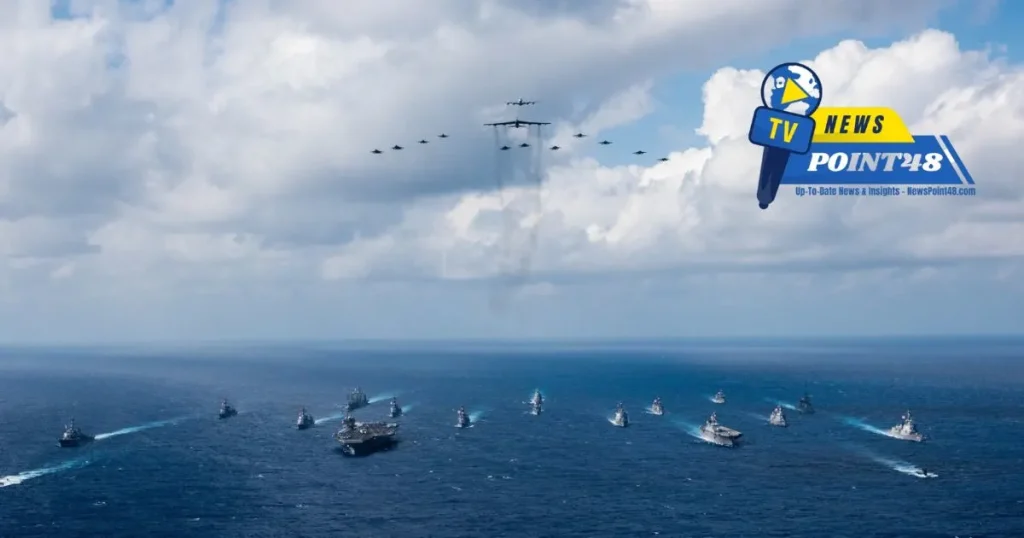
Category: News Blogs
Website: Newspoint48
The Indo-Pacific is emerging as a key region in great power politics, and its military capabilities — rankings of the armed forces by global firepower. As one of the world’s largest economiesand home to some of the most strategically important waterways, economic rivalry, territorial disputes, and enhanced military capabilities have resulted in rising tensions. The changing military power rankings of many nations, including China, India, Japan, Australia, and the United States highlight shifts in global geopolitics that could become more pronounced in years to come.
Here we look at what these military rankings mean for the geopolitical balance of power in the Indo-Pacific and global stability.
The Dominance Of The Chinese Military
One of the defining features of China’s ascendance as a global superpower has been its swift military modernization. The nation has in recent years made significant increases to its defense budget — now the second-largest globally — and invested extensively in its naval, aerial, and missile defenses. To that end, Beijing has sought to effectively colonize the South China Sea by building artificial islands in the field and militarizing them with defense-related infrastructure under the protection of its armed forces, known collectively as the People’s Liberation Army (PLA).
BEIJING: China is looking to expand its growing military presence in the Indo-Pacific at newspoint48 region by increasing investments and commercial agreements with small nations in Asia. China is taking advantage of the Belt and Road Initiative (BRI), and its Djibouti base in propelling its global presence, with key maritime regions being critical to this objective. This development places China near the top of almost all military power rankings and makes China a challenge to what has been a long-standing relative advantage of the United States in its Asia-Pacific region.
Yet at the same time, China’s assertive position in the Indo-Pacific also has provoked other neighbors and rival powers to re-orient their strategies militarily, leading to an increase in overall military competition.
India’s Military Expansion in Pursuit of China.
Tensions continue to rise between China and India, and so is India, a major player in the Indo-Pacific, which increases its military strength against the growing dominance of China. India is currently the largest democracy in the world and one of the biggest economies, has maintained a large military through agreements like the Quadrilateral Security Dialogue (Quad) with allies such as the US, Japan, and Australia behind it.
India’s military modernization is also geared towards boosting its naval and air power projection to check Chinese presence in the Indian Ocean region and protect its maritime frontiers. India’s Defence Acquisition and Production also need to focus on the acquisition of cutting-edge technology in defense; these steps include (interest S-400 missile defense System from Russia), and increasing indigenous defense production, as all this strength will Improve India’s Ranking In The Offensive Military Power Status Of The Indo-Pacific.
This has also culminated in India’s growing military exercises and engagements with Southeast Asia which indicates its clear intent for a stable, rule-based, multipolar Indo-Pacific.
The U.S. and Its Indo-Pacific Strategy

The US is still the preeminent military power in the Indo-Pacific, though. The U.S. Indo-Pacific Command, the largest of the six geographic combatant commands also has forged alliances built defense facilities, and intensified its partnerships with countries around such as Japan, South Korea, Australia, etc.
The US Navy’s 7th Fleet is a key force for keeping the peace in disputed waters such as the South China Sea, which have become hotspots of tension and are some of the world’s most important maritime trade routes. Furthermore, the USA is reinforcing ties with other nations since the Quad building closer alliances with countries like India, Japan, and Australia which are used to grab all with “free and open Indo-Pacific”.
Yet the U.S. is also stretched thin between its gaze on the Indo-Pacific and how it can respond to global conflicts such as the ongoing war in Ukraine and hostilities in the Middle East. The changing perceptions of the U.S. role in the Indo-Pacific have trickled into military power rankings, leading a few experts to claim that China is closing in on regional superiority.
Military Capabilities of Japan and Australia;
Boosting military and security capabilities — Japan is deeply engaged in reshaping its defense posture, and Australia — Like the United States, two other key Indo-Pacific allies have been making important progress in expanding their military credibility. For nearly 7 decades, Japan has been held back from having a more aggressive military force due to its pacifist constitution conceived in the wake of World War II. Led by Prime Minister Fumio Kishida, Japan has pledged to increase its defense budget, procure cutting-edge military hardware, and deepen security cooperation with the United States and other regional partners.
Australia has also increased its defense activities to meet the increasing strategic challenges in the Indo-Pacific. The AUKUS pact is a trilateral security agreement with the U.S. and the U.K. which will further reinforce Australia’s commitment to obtaining nuclear submarines, as well as strengthening military deterrence capabilities. Other factors, including Australia’s security leadership in the region and strategic relationships with ASEAN member states (though not as strong under PM Abbott), suggest it will maintain its place among growing military powers.
ASEAN and Other Small Indo-Pacific Nations
Although China, India, and the U.S. are big players and monopolies in regional military power rankings, smaller Indo-Pacific nations have also been reviewing their defense strategies. The Association of Southeast Asian Nations (ASEAN) —a regional bloc of 10 countries, is a vital player in upholding peace and security and developing economic prowess across the region.
Several ASEAN countries like Vietnam, the Philippines, and Indonesia are spending more on military modernization to secure their waters and promote sovereignty in claim hotspots. They also wish to balance between engaging with great powers like the US and China without getting too friendly with either.
While none of the region’s smaller nations boast significant military power on its own, collectively they are central actors in shaping the Indo-Pacific geopolitical environment.
Read the Shifting Geopolitics and for the Future of Indo-Pacific Security

The changing military power rankings in the Indo-Pacific signals a larger realignment of geopolitics. India, Japan, and Australia are ramping up their defense capabilities to limit the spread of Chinese dominance. Washington continues to pursue its interests of influence, but the ground is shifting.
These countries and hence the future Indo-Pacific security are prized for how well they can not only balance rising tensions but also keep these conflicts in stasis while allowing cooperation between each other. The regional security architecture will, in the long run, be largely molded by multilateral forums like Quad and ASEAN as well as strategic alliances such as AUKUS.
Indo-Pacific military power index: a test of the region’s growing global influence Amid Geopolitical Tensions, Defense Capabilities are Growing, and Alliances are Weakening The Indo-Pacific — international relations earthquake that no one saw coming is repeated competition in the military and geopolitical arenas will be the dominant trend in this region, with global ramifications for peace and stability.
